Borussia Dortmund – Schalke 3:0
Borussia Dortmund bounced back from their midweek loss to Juventus to extend their Bundesliga winning run to four matches with a complete domination of a defensive Schalke side in the Ruhr derby.
Dortmund had many defensive injuries with Sokratis, Piszczek, Durm, and Großkreutz all out. Kevin Kampl was also absent. Schalke had numerous absentees, most notably Draxler and Matip.
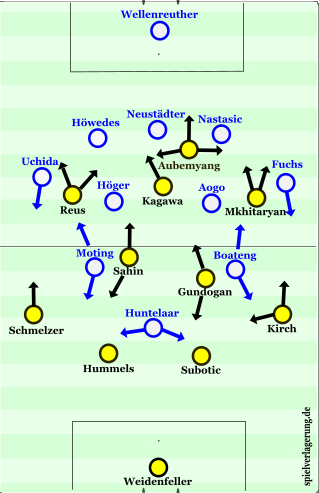
Dortmund played their standard 4-2-3-1. Schalke played an unusual (yet boring) variant on a 5-4-1, more of a 5-2-2-1.
Schalke’s defensive shape
During Dortmund circulation, Schalke adopted the 5-2-2-1 shape shown above with the midfield four in a square shape. Boateng and Choupo-Moting were either side of Huntelaar and slightly deeper than him, their main role was to prevent Dortmund’s double pivot from receiving the ball.
When the ball was with one of BVB’s fullbacks in Schalke’s half, the corresponding Schalke fullback (on same side as ball) would push up level with Hoger and Aogo, while either Boateng or Choupo-Moting would drop back on the other side. The inside forward that was on the same side of the ball would stay advanced, creating a 4-4-1-1. This was presumably to stop Dortmund getting into advanced positions with wide-build up. Having one of the inside forwards slightly higher like Moting below is beneficial as they can press the fullback, and also are in an advantageous transitional position.
When Dortmund had the ball in the final third, Schalke would drop to a back five and have the midfield and defensive lines very close together. This would give Gundogan or Sahin, or both, lots of time and space to either shoot or pass.
Dortmund sometimes pushed a full-back up onto the last line to create a 5vs5. Dortmund used this to exploit Schalke’s man-orientated zonal marking on one occasion with Kagawa dropping, opening up a passing lane for Hummels to pay a long through ball to Reus. Despite Schalke’s defensive approach, or ‘Mattenaccio’ if you will, Dortmund had 31 shots.
BVB’s attacking play
Dortmund were allowed 62.4% of possession. You would think this doesn’t suit their typical style of play but Dortmund made it work for them. They circulated among the back four, aiming to find a long vertical pass either to a man just in front of Schalke’s defence with space to turn, or behind the defence, to utilise the pace of Aubemyang and Reus. Gundogan and Sahin got 77 and 64 touches respectively while all of BVBs defenders managed over 80 touches, with Hummels registering a highly impressive 104 touches. This shows how vertical Dortmund were.
Dortmund’s front four didn’t track back into their own first third which was beneficial in transition as the player would have options on the left, in the centre, and on the right, as well as the over-the-top option to Aubemyang.
BVB also gained superiority through overloads. Their double pivot often shifted to each side to create overloads with both Gundogan and Sahin in the halfspaces.
They also used central overloads effectively. The BVB fullbacks would move inside, distracting Schalke’s inside forwards to cause this advantage, as illustrated and explained below.
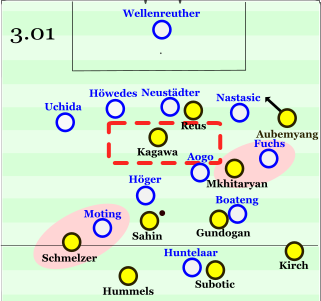
Schmelzer moves inside, causing Moting to stay near to him. Hoger must press Sahin, leaving Kagawa in space in between the lines. Sahin plays it to Kagawa who can turn and play a through ball to Aubemyang.
Later on in the match, Dortmund regularly used long, high balls aimed over the Schalke defence. For Dortmund’s first goal, an over-the-top ball was cleared by Neustadter however the Schalke defence failed to drop with him, meaning he played both Reus and Aubemyang onside after the clearance was picked up on the edge of the area by a Dortmund player.
Something similar happened for Dortmund’s second, just two minutes after. A long ball was headed back upfield but was picked up by a Dortmund player and sent wide. Mkhitaryan took up a position to the left of Howedes, but not far left enough to allow Uchida to come inside him and clear. He converts Gundogan’s cross.
When Schalke had possession
Schalke were offensively inept, not getting a single shot on target in the match. The only time they threatened BVB all match was a situation where they managed to play a long ball behind Dortmund’s press,creating a 3vs2 situation with their three most advanced players on Hummels and Subotic.
Dortmund pressed mostly in a 4-3-3/4-2-1-3 shape with Reus, Aubemyang, and Mkhitaryan making up the most advanced three. They didn’t press the last line often, only if there was a definite chance to isolate the player on the ball. Their pressing was mostly oriented around preventing Schalke moving into their second build-up phase. They pressed in twos on either of the Schalke double pivot if they tried to drop deep to pick up the ball from the centre-backs. Also, the Dortmund fullbacks would press the Schalke wingbacks as soon as a pass was played to them.
Another cause of Schalke’s lack of chances and low possession, just 37.6%, was Dortmund’s fantastic gegenpressing. Below is an example of Dortmund’s gegenpress.
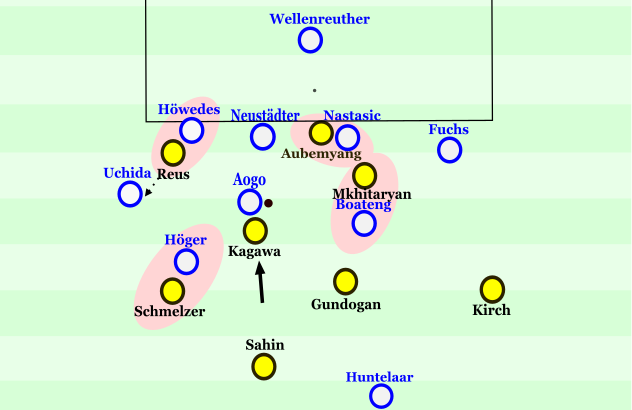
1) (53.14) Dortmund lose the ball to Aogo and Kagawa immediately is the man that presses him. Schmelzer moves up tight to Hoger, Mkhitaryan moves toward Boateng, Aubemyang moves the other side of Nastasic and Reus is between Howedes and Uchida. This is interesting as Dortmund are more famous for space-oriented counter press, with all players moving in the direction of the ball-carrier.
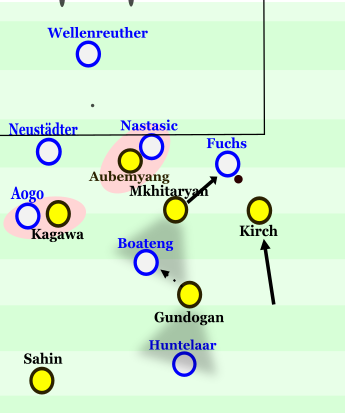
2) Aogo manages to switch the ball to Fuchs. Kirch immediately moves up towards him, as does Mkhitaryan who also cover shadows Boateng at the same time. Gundogan cover shadows Huntelaar, while being in proximity to Boateng. Kagawa and Aubemyang stay tight to their men. Fuchs attempts a pass to Huntelaar which is intercepted by Gundogan.
Conclusion
BVB ARE BACK! They played well with and without the ball, and made a statement to the rest of the Bundesliga, now only 8 points of a Champions League place. They will probably (in my opinion) be knocked out of this season’s Champions league by Juventus, but this means they can focus on qualification for next season.
A pretty dreadful performance from Schalke. They are only one point off fourth position but will be a lot further down the league by the end of the season if they carry on playing with as little attacking threat as they did on Saturday.
With Juventus, Chelsea and Bayern well clear at the top of their respective leagues, the race for Champions League places will be paid more attention than ever. The Bundesliga will be no exception.
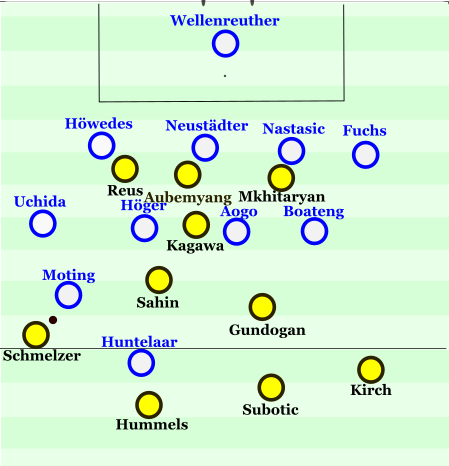
Keine Kommentare vorhanden Alle anzeigen